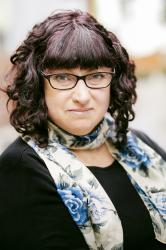Madeleine
Madeleine is the second in a cycle of works by Black Sequin Productions exploring mental illness. Following bi-polar Kitten in 2008, Madeleine explores the effects of schizophrenia.
Jenny Kemp and Black Sequin ProductionsArts House, Melbourne Friday 6 August 2010

Director and writer Jenny Kemp says, “I am interested in how we can deal with mental illness, in a way that is positive and not one of denial.” She is fascinated by the logic of the mentally ill and details her fascination on the stage.
Maddy is 19 and hears voices (as do the audience) that tell her she is a bride of Christ and responsible for the creation and care for the new Garden of Eden. Maddy’s prodigal sister is desperate to get her help, her mother (also Madeleine) is angry that Maddy is controlling their lives and her father is doing what he can to help her survive her own world.
Like Kitten, Maddy is almost a textbook study of a disease. She has lived with trauma (her twin drowned in the bath as a baby), is obsessed with menstrual blood, hears logical voices and dreams that she is raped by whispering voices in the dark – voices that could belong to God. And, also like Kitten, for all the moving performances and visual beauty, it feels too much like an academic study trying to be a community service announcement.
The dialogue is honest, but never sounds real because it lacks subtext. Lines like, “Drugs are not the solution, she needs love” are at home in nightly soaps and don’t feel right coming from the mouths of a family whose coping method is denial and non-communciation.
Nikki Sheils’s performance as Maddy is engaging and brave, but she is played like a disease, not a person. Ironically by the end of the night, we know all about Maddy’s illness, but too little about Maddy. This story about damaged people coping and could be so much more powerful if the obvious religious symbolism and “this is what the disease is like” scenes were reduced to glimpses and moments, so that the audience (of intelligent people) could be free to care about the people rather than watch the disease at work.
It’s hard not to compare Madeleine to Malthouse’s current Sappho…in 9 Fragments as they both developed from academic perspectives. Sappho is far more academic, but it reaches our hearts because it sits in a recogniseable world with people who we understand, while Madeline, which has the stronger story, distances us, even if it does give us a lot of information about mental illness. www.artshouse.com.au

